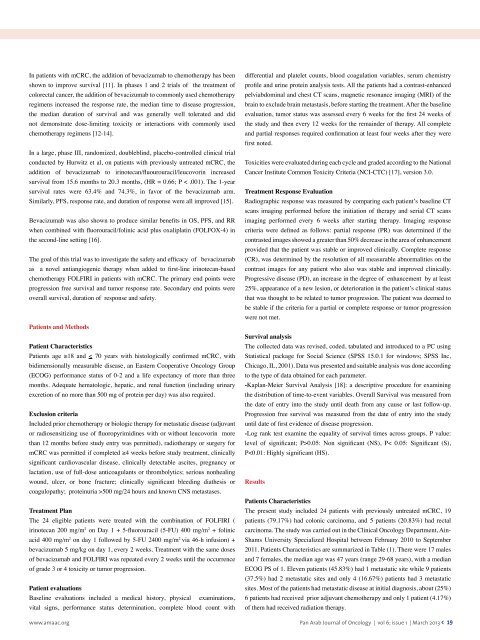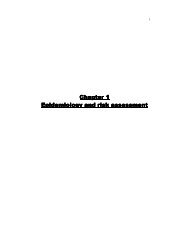Pan Arab Journal of Oncology - Arab Medical Association Against ...
Pan Arab Journal of Oncology - Arab Medical Association Against ...
Pan Arab Journal of Oncology - Arab Medical Association Against ...
You also want an ePaper? Increase the reach of your titles
YUMPU automatically turns print PDFs into web optimized ePapers that Google loves.
In patients with mCRC, the addition <strong>of</strong> bevacizumab to chemotherapy has beenshown to improve survival [11]. In phases 1 and 2 trials <strong>of</strong> the treatment <strong>of</strong>colorectal cancer, the addition <strong>of</strong> bevacizumab to commonly used chemotherapyregimens increased the response rate, the median time to disease progression,the median duration <strong>of</strong> survival and was generally well tolerated and didnot demonstrate dose-limiting toxicity or interactions with commonly usedchemotherapy regimens [12-14].In a large, phase III, randomized, doubleblind, placebo-controlled clinical trialconducted by Hurwitz et al, on patients with previously untreated mCRC, theaddition <strong>of</strong> bevacizumab to irinotecan/fluourouracil/leucovorin increasedsurvival from 15.6 months to 20.3 months, (HR = 0.66; P < .001). The 1-yearsurvival rates were 63.4% and 74.3%, in favor <strong>of</strong> the bevacizumab arm.Similarly, PFS, response rate, and duration <strong>of</strong> response were all improved [15].Bevacizumab was also shown to produce similar benefits in OS, PFS, and RRwhen combined with fluorouracil/folinic acid plus oxaliplatin (FOLFOX-4) inthe second-line setting [16].The goal <strong>of</strong> this trial was to investigate the safety and efficacy <strong>of</strong> bevacizumabas a novel antiangiogenic therapy when added to first-line irinotecan-basedchemotherapy FOLFIRI in patients with mCRC. The primary end points wereprogression free survival and tumor response rate. Secondary end points wereoverall survival, duration <strong>of</strong> response and safety.Patients and MethodsPatient CharacteristicsPatients age ≥18 and < 70 years with histologically confirmed mCRC, withbidimensionally measurable disease, an Eastern Cooperative <strong>Oncology</strong> Group(ECOG) performance status <strong>of</strong> 0-2 and a life expectancy <strong>of</strong> more than threemonths. Adequate hematologic, hepatic, and renal function (including urinaryexcretion <strong>of</strong> no more than 500 mg <strong>of</strong> protein per day) was also required.Exclusion criteriaIncluded prior chemotherapy or biologic therapy for metastatic disease (adjuvantor radiosensitizing use <strong>of</strong> fluoropyrimidines with or without leucovorin morethan 12 months before study entry was permitted), radiotherapy or surgery formCRC was permitted if completed ≥4 weeks before study treatment, clinicallysignificant cardiovascular disease, clinically detectable ascites, pregnancy orlactation, use <strong>of</strong> full-dose anticoagulants or thrombolytics; serious nonhealingwound, ulcer, or bone fracture; clinically significant bleeding diathesis orcoagulopathy; proteinuria >500 mg/24 hours and known CNS metastases.Treatment PlanThe 24 eligible patients were treated with the combination <strong>of</strong> FOLFIRI (irinotecan 200 mg/m 2 on Day 1 + 5-fluorouracil (5-FU) 400 mg/m 2 + folinicacid 400 mg/m 2 on day 1 followed by 5-FU 2400 mg/m 2 via 46-h infusion) +bevacizumab 5 mg/kg on day 1, every 2 weeks. Treatment with the same doses<strong>of</strong> bevacizumab and FOLFIRI was repeated every 2 weeks until the occurrence<strong>of</strong> grade 3 or 4 toxicity or tumor progression.Patient evaluationsBaseline evaluations included a medical history, physical examinations,vital signs, performance status determination, complete blood count withdifferential and platelet counts, blood coagulation variables, serum chemistrypr<strong>of</strong>ile and urine protein analysis tests. All the patients had a contrast-enhancedpelviabdominal and chest CT scans, magnetic resonance imaging (MRI) <strong>of</strong> thebrain to exclude brain metastasis, before starting the treatment. After the baselineevaluation, tumor status was assessed every 6 weeks for the first 24 weeks <strong>of</strong>the study and then every 12 weeks for the remainder <strong>of</strong> therapy. All completeand partial responses required confirmation at least four weeks after they werefirst noted.Toxicities were evaluated during each cycle and graded according to the NationalCancer Institute Common Toxicity Criteria (NCI-CTC) [17], version 3.0.Treatment Response EvaluationRadiographic response was measured by comparing each patient’s baseline CTscans imaging performed before the initiation <strong>of</strong> therapy and serial CT scansimaging performed every 6 weeks after starting therapy. Imaging responsecriteria were defined as follows: partial response (PR) was determined if thecontrasted images showed a greater than 50% decrease in the area <strong>of</strong> enhancementprovided that the patient was stable or improved clinically. Complete response(CR), was determined by the resolution <strong>of</strong> all measurable abnormalities on thecontrast images for any patient who also was stable and improved clinically.Progressive disease (PD), an increase in the degree <strong>of</strong> enhancement by at least25%, appearance <strong>of</strong> a new lesion, or deterioration in the patient’s clinical statusthat was thought to be related to tumor progression. The patient was deemed tobe stable if the criteria for a partial or complete response or tumor progressionwere not met.Survival analysisThe collected data was revised, coded, tabulated and introduced to a PC usingStatistical package for Social Science (SPSS 15.0.1 for windows; SPSS Inc,Chicago, IL, 2001). Data was presented and suitable analysis was done accordingto the type <strong>of</strong> data obtained for each parameter.-Kaplan-Meier Survival Analysis [18]: a descriptive procedure for examiningthe distribution <strong>of</strong> time-to-event variables. Overall Survival was measured fromthe date <strong>of</strong> entry into the study until death from any cause or last follow-up.Progression free survival was measured from the date <strong>of</strong> entry into the studyuntil date <strong>of</strong> first evidence <strong>of</strong> disease progression.-Log rank test examine the equality <strong>of</strong> survival times across groups. P value:level <strong>of</strong> significant; P>0.05: Non significant (NS), P< 0.05: Significant (S),P









